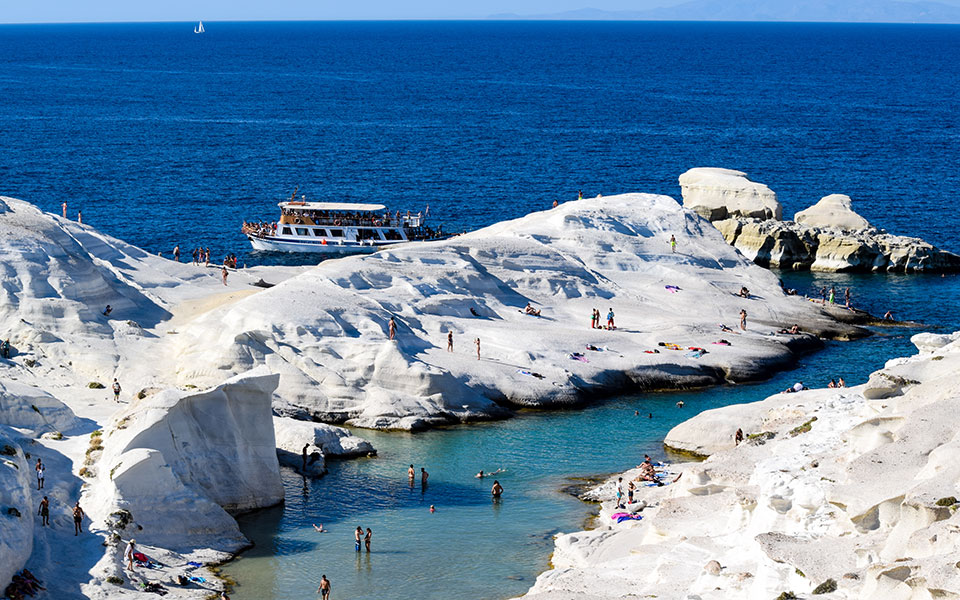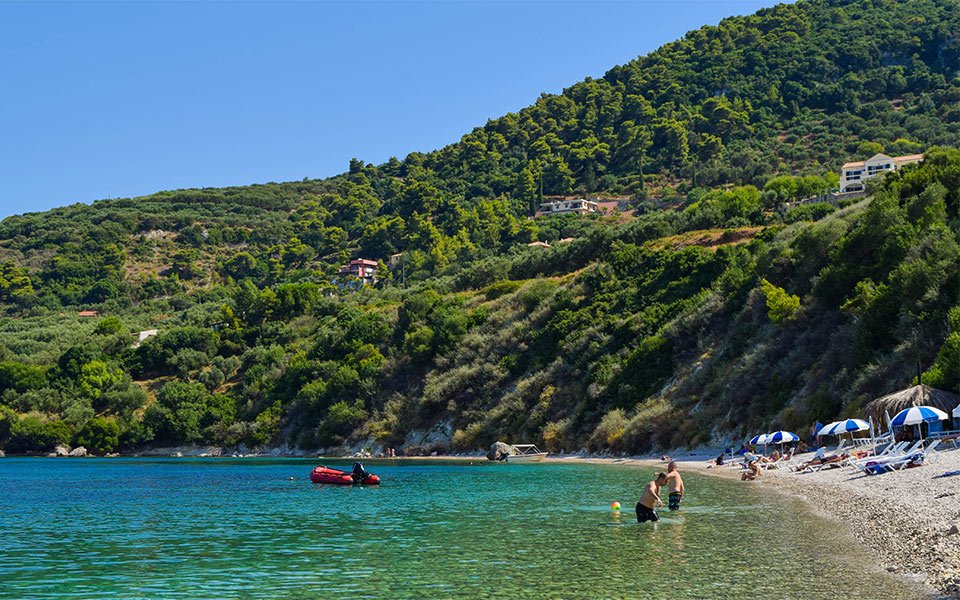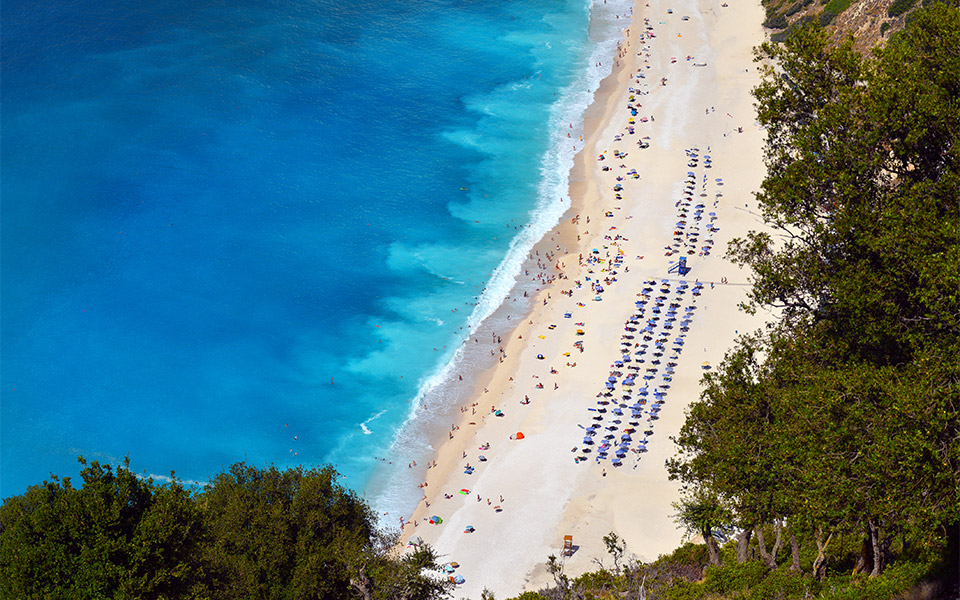“I don’t like sand. It’s coarse and rough and irritating and it gets everywhere.” This may be Anakin Skywalker’s most mocked line from the Star Wars movies, but for some it rings true.
Greece is a country full of jaw-droppingly gorgeous beaches, and the most commonly preferred ones among them are the sandy ones. However, while a golden sandy beach may be most people’s idea of the perfect summer setting, we’d like to give a shout-out to the rocky shores, and the pebble beaches which have plenty of their own merits.
Why should you chose a non-sandy beach? First of all, like Anakin Skywalker notes: sand gets everywhere. Jumping off rocks into the sea or lying on a strip of smooth pebbles, you won’t have to deal with sand sticking to your sunblock-sticky skin, sneaking its way into your bag, and getting in your eyes. It’s also the cleaner option if your a germaphobe, as sand often contains plenty of bacteria. The water around pebble beaches also tends to be clearer as there’s is no silt on the seabed to be churned up by waves or swimmers, and they usually are more interesting places to snorkel.
Finally, since sandy beaches are the mainstream option, going the other way means you usually don’t have to deal with crowds, and can often find yourself alone at your own little piece of paradise by the sea.
Below are some of our favourite sand-less swimming spots.

Kavourotripes, Sithonia
Halkidiki is famous for its gorgeous stretches of sand, and is the regional unit of Greece with the most Blue Flag awarded beaches. You’ll find amazing waters on the middle leg of the peninsula, Sithonia. For those who like to avoid sand, we love Kavourotripes. The name means “crab holes”, and like crabs, visitors search for find good spots to relax everywhere on and between the rocks as near the sea as possible. There are also patches of sand for those who prefer building castles to diving of the rocks. Sun beds are available at the central sandy part, where you can also buy drinks and snacks.

© Shutterstock
Damouchari, Pilio
The village of Damouchari, on the eastern coast of the Pilio peninsula, is famous, mostly for being featured in the 2008 film adaption of the musical Mamma Mia, and it’s easy to understand why the place was chosen. Reachable only by boat or by foot down the hill from the road to Tsagarada, it is a remote paradise with a beautiful white pebble beach. While not the place to take small children, it is great for older kids and young people as there are many things to explore; there’s a small cave, rocks to jump off, and even a great natural rock face to climb. There is also a nice taverna just above the beach.

© Pericles Merakos
Lalaria, Skiathos
This beach is the perfect compromise when sand lovers and haters get together. The beautiful Lalaria beach consists of small white pebbles – soft to sit on, but don’t blow around or stick to your skin like sand. Also, it’s a lot more than just a good compromise. Some would call this secluded beach paradise. Be advised that it’s only accessible by boat and only when the sea is calm.
Sotos, Aegina
Next to the long, Blue Flag-awarded sandy beach in Aghia Marina on the island of Aegina, Sotos is a beach bar built into a cave. Below the bar, on a large rock that stretches out into the sea, you’ll find tables, sun beds, and a trampoline. For those afraid to leap into the clear blue sea, there are ladders.

© Shutterstock
Sarakiniko, Milos
The island of Milos is famous for its unreal-looking beaches with various spectacular rock formations. Some are sandy with tall rock pillars rising from the water, but the most photographed of them all is probably Sarakiniko. The white, volcanic rock from which you dive into the bright blue water creates a lunar-like landscape, and the fascinating seabed is perfect for those who love snorkeling. It’s not organized and there is no shade, so bring a hat, umbrella and lots of water.

© Shutterstock
Chalkiada, Agistri
The island of Agistri is only about an hour away from Piraeus, but the crystal-clear turquoise waters can make you think you’re in the Caribbean. The non-organized white stone beach of Chalkiada is reachable by foot from the port of Skala. It’s not far, though you need to be in good physical shape as reaching it requires climbing and walking through water on slippery rocks. Popular with campers, you will easily find it by following the trail of tents and hammocks strung between the trees. It can get quite crowded in July and August (and note that camping here is actually technically illegal). Wear sturdy sandals, and bring lots of sun block and water, as there is very little shade.

© Shutterstock
Anthony Quinn Bay, Rhodes
This beach, named after the famous actor who fell so hard for its beauty while filming The Guns of Navarone that he actually tried to buy it, is small and gets very crowded, so it’s a good idea to get here early. Surrounded by green and with emerald waters, skip the sun beds on the sand and relax in the shade of the pine trees up the slope, or on the rocks that stretch out into the sea.

Ηoulakia, Mykonos
Most of the beaches on Mykonos are sandy, organized, and packed with people. If you want something different while you’re here, this is the right spot for many reasons. Few people come here aside from the locals, and the beach is not only the only white pebble beach on the island, but secluded, rugged, and largely devoid of tourism.

© Shutterstock
Mavra Volia, Chios
At this beach on the island of Chios, the pebbles are black. It has a different kind of charm than a common white or golden beach, with enticing dark blue and refreshingly cold water. Get here from the small port of Emporios, where you’ll also find tavernas and shops where you can stock up on water and snacks.

© Pericles Merakos
Seychelles, Ikaria
At this beach, you may come across some sand, but there are also plenty of spots to lay your towel down on large pebbles, and rocks to lounge on for those who prefer it. It’s quite hard to reach the beach, with the path from the village of Manganitis getting steeper towards the end, but it’s worth it once you get there. If you prefer to avoid that struggle, you can take a boat from the village.
Fokianos, Leonidio
The white pebble beaches around Leonidio in the Peloponnese are largely untouched and perfect for families with children. Head to one of them, like the long beautiful Fokianos beach, for a relaxed time with lots of space to run and play. There is a beach bar, but it’s just as comfortable to sit on a towel as on a sun bed, as the pebbles here are very smooth.

Foneas, Messinia
Located about 2.5 kilometers from Kardamyli, and reachable by foot following a path through the woods from the main road, Foneas beach is a sight for sore eyes. A large rock cuts the small white pebble beach in half and provides shade, and a family-run canteen serves drinks and great freshly grilled souvlaki and salads (although there are no sun beds). There are also some fun rocks out in the sea to climb on and jump off. While small, it is usually not too crowded, making it feel like a tiny hidden oasis, and a secret you shouldn’t share.

© Shutterstock
Marathias, Zakynthos
While your first day in Zakynthos may be earmarked for the famous Navagio (shipwreck) beach, you’ll probably feel like something a little less tourist-packed the next day. At the sheltered and non-organized Marathias beach, on the south side of the island near Keri, you can enjoy the calm and crystal clear waters. Lush green surrounds the white pebble beach, where you can find shade under the pine trees.

© Shutterstock
Antisamos, Kefalonia
Close to the port of Sami, Antisamos is almost blindingly white between the green hills and the turquoise waters of Kefalonia. Famous since having been featured in the 2001 film Captain Corelli’s Mandolin, this pebble beach is a popular choice with tourists and locals alike. The beach is organized, with umbrellas, sun beds and a beach bar.

© Shutterstock
Myrtos, Kefalonia
Myrtos is another world-famous beach on Kefalonia, featuring the same beautiful bright white pebbles. Surrounded by tall and steep green hills, it is an incredible sight from above, and one of the most photographed and talked about beaches in Greece. You’ll find sun beds and a canteen here, but there’s also tons of space to put your towel down. Locate on the island’s more exposed coast, when the wind is up the beach gets pounded by sizeable waves, making for an exhilarating experience. Proving that pebbles are just as good as sand, it’s often named one of the best beaches in the world!

© Shutterstock
Porto Katsiki, Lefkada
This beach on the northwest peninsula of Lefkada is sometimes talked about as a sandy beach. In reality, it’s covered in small white pebbles which are so smooth, they look like sand from afar. The dramatic, steep cliffs behind the beach reflect the white of the stones, making the whole scene resemble what most imagine heaven to look like, with the clear blue sea below. The beach is organized, with plenty of sunbeds. There are steps to get down to the beach although its a bit of a steep climb – not that this puts off many visitors; the beach tends to get quite busy during the high season.











